读《意识形态和意识形态国家机器》
论阿尔都塞的意识形态国家机器理论及对当代中国的启示

论阿尔都塞的意识形态国家机器理论及对当代中国的启示作者:王晨晨来源:《青年时代》2020年第04期摘要:阿尔都塞是二十世纪最具影响力的意识形态理论解释者,他在《意识形态与意识形态的国家机器》(研究笔记)一书中提出意识形态国家机器的新概念,对后世产生了深远影响。
本文运用文本研究的方法,探讨了意识形态国家机器的概念、功能和作用,以期对当代中国加强意识形态国家机器的建设有所启示。
关键词:阿尔都塞;《意识形态和意识形态国家机器》(研究笔记);意识形态国家机器。
一、阿尔都塞的意识形态理论意识形态这一概念最早出现于19世纪初,由法国思想家特拉西提出。
1814年,特拉西出版了《意识形态的要素》,特拉西用这个概念建立了一个“观念科学”,它主要来研究人的心灵和认知等方面的内容。
1845年,马克思和恩格斯在撰写的《德意志意识形态》中,使用了这一概念,并使其内涵发生了变化,主要是指具有一定社会经济和政治观点的总和,反映了某个社会的经济基础、政治制度以及人民之间的关系,这种意识形态是通过统治阶级从上而下的向全体社会成员提出,它具有一些虚假性。
后来,列宁重新定义意识形态的概念,他认为,在阶级斗争中,意识形态主要代表统治阶级的利益,如果对意识形态批判,它必然会使统治阶级的利益受到侵犯。
阿尔都塞的意识形态理论可以分为两个不同的阶段,第一阶段以《保卫马克思》为标志,第二阶段以《意识形态和意识形态的国家机器》(研究笔记)为标志。
在第一阶段,阿尔都塞主要从认识论的角度来探讨意识形态。
首先,他关注科学与意识形态的区别。
阿尔都塞指出,科学反映的是对于现实和社会历史的真理性认识,它不代表并反映任何一个阶级的利益。
另一方面,意识形态一种则是“虚假意识”,它不是谬误,不能反映社会历史进程的真实情况,总是体现某阶级的利益。
第二,意识形态是一种实践。
阿尔都塞指出,实践并不是什么,它是通过对某种物质进行加工使其成为某种产品。
阿尔都塞认为,实践主要包括社会实践、政治实践和意识形态实践。
意识形态与意识形态国家机器
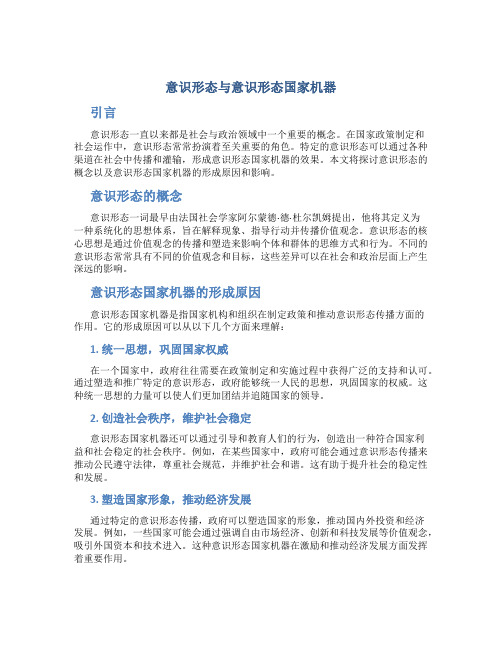
意识形态与意识形态国家机器引言意识形态一直以来都是社会与政治领域中一个重要的概念。
在国家政策制定和社会运作中,意识形态常常扮演着至关重要的角色。
特定的意识形态可以通过各种渠道在社会中传播和灌输,形成意识形态国家机器的效果。
本文将探讨意识形态的概念以及意识形态国家机器的形成原因和影响。
意识形态的概念意识形态一词最早由法国社会学家阿尔蒙德·德·杜尔凯姆提出,他将其定义为一种系统化的思想体系,旨在解释现象、指导行动并传播价值观念。
意识形态的核心思想是通过价值观念的传播和塑造来影响个体和群体的思维方式和行为。
不同的意识形态常常具有不同的价值观念和目标,这些差异可以在社会和政治层面上产生深远的影响。
意识形态国家机器的形成原因意识形态国家机器是指国家机构和组织在制定政策和推动意识形态传播方面的作用。
它的形成原因可以从以下几个方面来理解:1. 统一思想,巩固国家权威在一个国家中,政府往往需要在政策制定和实施过程中获得广泛的支持和认可。
通过塑造和推广特定的意识形态,政府能够统一人民的思想,巩固国家的权威。
这种统一思想的力量可以使人们更加团结并追随国家的领导。
2. 创造社会秩序,维护社会稳定意识形态国家机器还可以通过引导和教育人们的行为,创造出一种符合国家利益和社会稳定的社会秩序。
例如,在某些国家中,政府可能会通过意识形态传播来推动公民遵守法律,尊重社会规范,并维护社会和谐。
这有助于提升社会的稳定性和发展。
3. 塑造国家形象,推动经济发展通过特定的意识形态传播,政府可以塑造国家的形象,推动国内外投资和经济发展。
例如,一些国家可能会通过强调自由市场经济、创新和科技发展等价值观念,吸引外国资本和技术进入。
这种意识形态国家机器在激励和推动经济发展方面发挥着重要作用。
意识形态国家机器的影响意识形态国家机器对社会和个体产生了深远的影响,包括:1. 形塑个体意识和行为意识形态通过灌输特定的价值观念和信仰,对个体的意识和行为产生影响。
意识形态与国家机器(英文版)
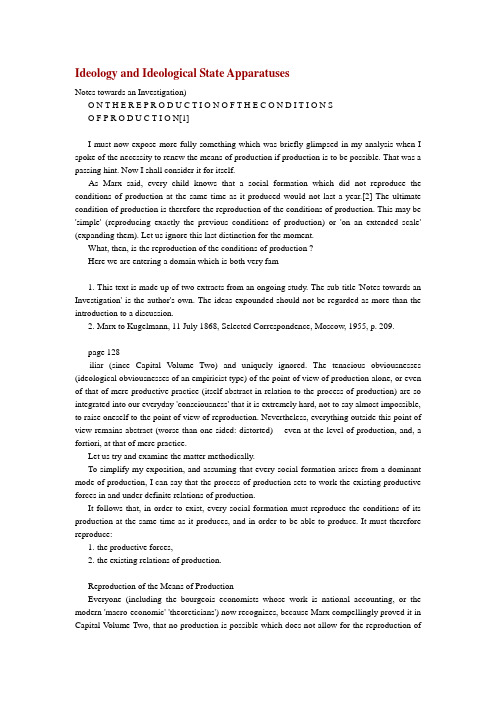
Ideology and Ideological State ApparatusesNotes towards an Investigation)O N T H E R E P R O D U C T I O N O F T H E C O N D I T I O N SO F P R O D U C T I O N[1]I must now expose more fully something which was briefly glimpsed in my analysis when I spoke of the necessity to renew the means of production if production is to be possible. That was a passing hint. Now I shall consider it for itself.As Marx said, every child knows that a social formation which did not reproduce the conditions of production at the same time as it produced would not last a year.[2] The ultimate condition of production is therefore the reproduction of the conditions of production. This may be 'simple' (reproducing exactly the previous conditions of production) or 'on an extended scale' (expanding them). Let us ignore this last distinction for the moment.What, then, is the reproduction of the conditions of production ?Here we are entering a domain which is both very fam-1. This text is made up of two extracts from an ongoing study. The sub-title 'Notes towards an Investigation' is the author's own. The ideas expounded should not be regarded as more than the introduction to a discussion.2. Marx to Kugelmann, 11 July 1868, Selected Correspondence, Moscow, 1955, p. 209.page 128iliar (since Capital V olume Two) and uniquely ignored. The tenacious obviousnesses (ideological obviousnesses of an empiricist type) of the point of view of production alone, or even of that of mere productive practice (itself abstract in relation to the process of production) are so integrated into our everyday 'consciousness' that it is extremely hard, not to say almost impossible, to raise oneself to the point of view of reproduction. Nevertheless, everything outside this point of view remains abstract (worse than one-sided: distorted) -- even at the level of production, and, a fortiori, at that of mere practice.Let us try and examine the matter methodically.To simplify my exposition, and assuming that every social formation arises from a dominant mode of production, I can say that the process of production sets to work the existing productive forces in and under definite relations of production.It follows that, in order to exist, every social formation must reproduce the conditions of its production at the same time as it produces, and in order to be able to produce. It must therefore reproduce:1. the productive forces,2. the existing relations of production.Reproduction of the Means of ProductionEveryone (including the bourgeois economists whose work is national accounting, or the modern 'macro-economic' 'theoreticians') now recognizes, because Marx compellingly proved it in Capital Volume Two, that no production is possible which does not allow for the reproduction ofthe material conditions of production: the reproduction of the means of production.The average economist, who is no different in this thanpage 129the average capitalist, knows that each year it is essential to foresee what is needed to replace what has been used up or worn out in production: raw material, fixed installations (buildings), instruments of production (machines), etc. I say the average economist = the average capitalist, for they both express the point of view of the firm, regarding it as sufficient simply to give a commentary on the terms of the firm's financial accounting practice.But thanks to the genius of Quesnay who first posed this 'glaring' problem, and to the genius of Marx who resolved it, we know that the reproduction of the material conditions of production cannot be thought at the level of the firm, because it does not exist at that level in its real conditions. What happens at the level of the firm is an effect, which only gives an idea of the necessity of reproduction, but absolutely fails to allow its conditions and mechanisms to be thought.A moment's reflection is enough to be convinced of this: Mr X, a capitalist who produces woollen yarn in his spinning-mill, has to 'reproduce' his raw material, his machines, etc. But he does not produce them for his own production -- other capitalists do: an Australian sheep farmer, Mr Y, a heavy engineer producing machine-tools, Mr Z, etc., etc. And Mr Y and Mr Z, in order to produce those products which are the condition of the reproduction of Mr X's conditions of production, also have to reproduce the conditions of their own production, and so on to infinity -- the whole in proportions such that, on the national and even the world market, the demand for means of production (for reproduction) can be satisfied by the supply.In order to think this mechanism, which leads to a kind of 'endless chain', it is necessary to follow Marx's 'global' procedure, and to study in particular the relations of the circulation of capital between Department I (production ofpage 130means of production) and Department II (production of means of consumption), and the realization of surplus value, in Capital, V olumes Two and Three.We shall not go into the analysis of this question. It is enough to have mentioned the existence of the necessity of the reproduction of the material conditions of production.Reproduction of Labour-PowerHowever, the reader will not have failed to note one thing. We have discussed the reproduction of the means of production -- but not the reproduction of the productive forces. We have therefore ignored the reproduction of what distinguishes the productive forces from the means of production, i.e. the reproduction of labour power.From the observation of what takes place in the firm, in particular from the examination of the financial accounting practice which predicts amortization and investment, we have been able to obtain an approximate idea of the existence of the material process of reproduction, but we are now entering a domain in which the observation of what happens in the firm is, if not totally blind, at least almost entirely so, and for good reason: the reproduction of labour power takes place essentially outside the firm.How is the reproduction of labour power ensured?It is ensured by giving labour power the material means with which to reproduce itself: by wages. Wages feature in the accounting of each enterprise, but as 'wage capital',[3] not at all as a condition of the material reproduction of labour power.However, that is in fact how it 'works', since wages represents only that part of the value produced by the expendi-3. Marx gave it its scientific concept: variable capital.page 131ture of labour power which is indispensable for its reproduction: sc. indispensable to the reconstitution of the labour power of the wage-earner (the wherewithal to pay for housing, food and clothing, in short to enable the wage earner to present himself again at the factory gate the next day -- and every further day God grants him); and we should add: indispensable for raising and educating the children in whom the proletarian reproduces himself (in n models where n = 0, 1, 2, etc. . . .) as labour power.Remember that this quantity of value (wages) necessary for the reproduction of labour power is determined not by the needs of a 'biological' Guaranteed Minimum Wage (Salaire Minimum Interprofessionnel Garanti ) alone, but by the needs of a historical minimum (Marx noted that English workers need beer while French proletarians need wine) -- i.e. a historically variable minimum.I should also like to point out that this minimum is doubly historical in that it is not defined by the historical needs of the working class 'recognized' by the capitalist class, but by the historical needs imposed by the proletarian class struggle (a double class struggle: against the lengthening of the working day and against the reduction of wages).However, it is not enough to ensure for labour power the material conditions of its reproduction if it is to be reproduced as labour power. I have said that the available labour power must be 'competent', i.e. suitable to be set to work in the complex system of the process of production. The development of the productive forces and the type of unity historically constitutive of the productive forces at a given moment produce the result that the labour power has to be (diversely) skilled and therefore reproduced as such. Diversely: according to the requirements of the socio-technical division of labour, its different 'jobs' and 'posts'.How is this reproduction of the (diversified) skills ofpage 132labour power provided for in a capitalist regime? Here, unlike social formations characterized by slavery or serfdom this reproduction of the skills of labour power tends (this is a tendential law) decreasingly to be provided for 'on the spot' (apprenticeship within production itself), but is achieved more and more outside production: by the capitalist education system, and by other instances and institutions.What do children learn at school? They go varying distances in their studies, but at any rate they learn to read, to write and to add -- i.e. a number of techniques, and a number of other things as well, including elements (which may be rudimentary or on the contrary thoroughgoing) of 'scientific' or 'literary culture', which are directly useful in the different jobs in production (oneinstruction for manual workers, another for technicians, a third for engineers, a final one for higher management, etc.). Thus they learn know-how.But besides these techniques and knowledges, and in learning them, children at school also learn the 'rules' of good behaviour, i.e. the attitude that should be observed by every agent in the division of labour, according to the job he is 'destined' for: rules of morality, civic and professional conscience, which actually means rules of respect for the socio-technical division of labour and ultimately the rules of the order established by class domination. They also learn to 'speak proper French', to 'handle' the workers correctly, i.e. actually (for the future capitalists and their servants) to 'order them about' properly, i.e. (ideally) to 'speak to them' in the right way, etc.To put this more scientifically, I shall say that the reproduction of labour power requires not only a reproduction of its skills, but also, at the same time, a reproduction of its submission to the rules of the established order, i.e. a reproduction of submission to the ruling ideology for thepage 133workers, and a reproduction of the ability to manipulate the ruling ideology correctly for the agents of exploitation and repression, so that they, too, will provide for the domination of the ruling class 'in words'.In other words, the school (but also other State institutions like the Church, or other apparatuses like the Army) teaches 'know-how', but in forms which ensure subjection to the ruling ideology or the mastery of its 'practice'. All the agents of production, exploitation and repression, not to speak of the 'professionals of ideology' (Marx), must in one way or another be 'steeped' in this ideology in order to perform their tasks 'conscientiously' -- the tasks of the exploited (the proletarians), of the exploiters (the capitalists), of the exploiters' auxiliaries (the managers), or of the high priests of the ruling ideology (its 'functionaries'), etc.The reproduction of labour power thus reveals as its sine qua non not only the reproduction of its 'skills' but also the reproduction of its subjection to the ruling ideology or of the 'practice' of that ideology, with the proviso that it is not enough to say 'not only but also', for it is clear that it is in the forms and under the forms of ideological subjection that provision is made for the reproduction of the skills of labour power.But this is to recognize the effective presence of a new reality: ideology.Here I shall make two comments.The first is to round off my analysis of reproduction.I have just given a rapid survey of the forms of the reproduction of the productive forces, i.e. of the means of production on the one hand, and of labour power on the other.But I have not yet approached the question of the reproduction of the relations of production. This is a crucial question for the Marxist theory of the mode of production.page 134To let it pass would be a theoretical omission -- worse, a serious political error.I shall therefore discuss it. But in order to obtain the means to discuss it, I shall have to make another long detour.The second comment is that in order to make this detour, I am obliged to re-raise my old question: what is a society ?I N F R A S T R U C T U R E A N D S U P E R S T R U C T U R EOn a number of occasions[4] I have insisted on the revolutionary character of the Marxist conception of the 'social whole' insofar as it is distinct from the Hegelian 'totality'. I said (and this thesis only repeats famous propositions of historical materialism) that Marx conceived the structure of every society as constituted by 'levels' or 'instances' articulated by a specific determination: the infrastructure, or economic base (the 'unity' of the productive forces and the relations of production) and the superstructure, which itself contains two 'levels' or 'instances': the politico-legal (law and the State) and ideology (the different ideologies, religious, ethical, legal, political, etc.).Besides its theoretico-didactic interest (it reveals the difference between Marx and Hegel), this representation has the following crucial theoretical advantage: it makes it possible to inscribe in the theoretical apparatus of its essential concepts what I have called their respective indices of effectivity. What does this mean?It is easy to see that this representation of the structure of every society as an edifice containing a base (infrastruc-4. In For Marx and Reading Capital, 1965 (English editions 1969 and 1970 respectively).page 135ture) on which are erected the two 'floors' of the superstructure, is a metaphor, to be quite precise, a spatial metaphor: the metaphor of a topography (topique ).[5] Like every metaphor, this metaphor suggests something, makes some thing visible. What? Precisely this: that the upper floors could not 'stay up' (in the air) alone, if they did not rest precisely on their base.Thus the object of the metaphor of the edifice is to represent above all the 'determination in the last instance' by the economic base. The effect of this spatial metaphor is to endow the base with an index of effectivity known by the famous terms: the determination in the last instance of what happens in the upper 'floors' (of the superstructure) by what happens in the economic base.Given this index of effectivity 'in the last instance', the 'floors' of the superstructure are clearly endowed with different indices of effectivity. What kind of indices ?It is possible to say that the floors of the superstructure are not determinant in the last instance, but that they are determined by the effectivity of the base; that if they are determinant in their own (as yet undefined) ways, this is true only insofar as they are determined by the base.Their index of effectivity (or determination), as determined by the determination in the last instance of the base, is thought by the Marxist tradition in two ways: (1) there is a 'relative autonomy' of the superstructure with respect to the base; (2) there is a 'reciprocal action' of the superstructure on the base.We can therefore say that the great theoretical advantage of the Marxist topography, i.e. of the spatial metaphor of5. Topography from the Greek topos : place. A topography represents in a definite space the respective sites occupied by several realities: thus the economic is at the bottom (the base), the superstructure above it.page 136the edifice (base and superstructure) is simultaneously that it reveals that questions of determination (or of index of effectivity) are crucial; that it reveals that it is the base which in the last instance determines the whole edifice; and that, as a consequence, it obliges us to pose the theoretical problem of the types of 'derivatory' effectivity peculiar to the superstructure, i.e. it obliges us to think what the Marxist tradition calls conjointly the relative autonomy of the superstructure and the reciprocal action of the superstructure on the base.The greatest disadvantage of this representation of the structure of every society by the spatial metaphor of an edifice, is obviously the fact that it is metaphorical: i.e. it remains descriptive.It now seems to me that it is possible and desirable to represent things differently. NB, I do not mean by this that I want to reject the classical metaphor, for that metaphor itself requires that we go beyond it. And I am not going beyond it in order to reject it as outworn. I simply want to attempt to think what it gives us in the form of a description.I believe that it is possible and necessary to think what characterizes the essential of the existence and nature of the superstructure on the basis of reproduction. Once one takes the point of view of reproduction, many of the questions whose existence was indicated by the spatial metaphor of the edifice, but to which it could not give a conceptual answer, are immediately illuminated.My basic thesis is that it is not possible to pose these questions (and therefore to answer them) except from the point of view of reproduction.I shall give a short analysis of Law, the State and Ideology from this point of view. And I shall reveal what happens both from the point of view of practice and production on the one hand, and from that of reproduction on the other.page 137T H E S T A T EThe Marxist tradition is strict, here: in the Communist Manifesto and the Eighteenth Brumaire (and in all the later classical texts, above all in Marx's writings on the Paris Commune and Lenin's on State and Revolution ), the State is explicitly conceived as a repressive apparatus. The State is a 'machine' of repression, which enables the ruling classes (in the nineteenth century the bourgeois class and the 'class' of big landowners) to ensure their domination over the working class, thus enabling the former to subject the latter to the process of surplus-value extortion (i.e. to capitalist exploitation).The State is thus first of all what the Marxist classics have called the State apparatus. This term means: not only the specialized apparatus (in the narrow sense) whose existence and necessity I have recognized in relation to the requirements of legal practice, i.e. the police, the courts, the prisons; but also the army, which (the proletariat has paid for this experience with its blood) intervenes directly as a supplementary repressive force in the last instance, when the police and its specialized auxiliary corps are 'outrun by events'; and above this ensemble, the head of State, the government and the administration.Presented in this form, the Marxist-Leninist 'theory' of the State has its finger on the essential point, and not for one moment can there be any question of rejecting the fact that this really is theessential point. The State apparatus, which defines the State as a force of repressive execution and intervention 'in the interests of the ruling classes' in the class struggle conducted by the bourgeoisie and its allies against the proletariat, is quite certainly the State, and quite certainly defines its basic 'function'.page 138From Descriptive Theory to Theory as suchNevertheless, here too, as I pointed out with respect to the metaphor of the edifice (infrastructure and superstructure), this presentation of the nature of the State is still partly descriptive.As I shall often have occasion to use this adjective (descriptive), a word of explanation is necessary in order to remove any ambiguity.Whenever, in speaking of the metaphor of the edifice or of the Marxist 'theory' of the State, I have said that these are descriptive conceptions or representations of their objects, I had no ulterior critical motives. On the contrary, I have every grounds to think that great scientific discoveries cannot help but pass through the phase of what I shall call descriptive 'theory '. This is the first phase of every theory, at least in the domain which concerns us (that of the science of social formations). As such, one might and in my opinion one must -- envisage this phase as a transitional one, necessary to the development of the theory. That it is transitional is inscribed in my expression: 'descriptive theory', which reveals in its conjunction of terms the equivalent of a kind of 'contradiction'. In fact, the term theory 'clashes' to some extent with the adjective 'descriptive' which I have attached to it. This means quite precisely: (1) that the 'descriptive theory' really is, without a shadow of a doubt, the irreversible beginning of the theory; but (2) that the 'descriptive' form in which the theory is presented requires, precisely as an effect of this 'contradiction', a development of the theory which goes beyond the form of 'description'.Let me make this idea clearer by returning to our present object: the State.When I say that the Marxist 'theory' of the State available to us is still partly 'descriptive', that means first and fore-page 139most that this descriptive 'theory' is without the shadow of a doubt precisely the beginning of the Marxist theory of the State, and that this beginning gives us the essential point, i.e. the decisive principle of every later development of the theory.Indeed, I shall call the descriptive theory of the State correct, since it is perfectly possible to make the vast majority of the facts in the domain with which it is concerned correspond to the definition it gives of its object. Thus, the definition of the State as a class State, existing in the repressive State apparatus, casts a brilliant light on all the facts observable in the various orders of repression whatever their domains: from the massacres of June 1848 and of the Paris Commune, of Bloody Sunday, May 1905 in Petrograd, of the Resistance, of Charonne, etc., to the mere (and relatively anodyne) interventions of a 'censorship' which has banned Diderot's La Réligieuse or a play by Gatti on Franco; it casts light on all the direct or indirect forms of exploitation and extermination of the masses of the people (imperialist wars); it casts light on that subtle everyday domination beneath which can be glimpsed, in the forms of political democracy, for example, what Lenin, following Marx, called the dictatorship of the bourgeoisie.And yet the descriptive theory of the State represents a phase in the constitution of the theory which itself demands the 'supersession' of this phase. For it is clear that if the definition in question really does give us the means to identify and recognize the facts of oppression by relating them to the State, conceived as the repressive State apparatus, this 'interrelationship' gives rise to a very special kind of obviousness, about which I shall have something to say in a moment: 'Yes, that's how it is, that's really true!'[6]6. See p. 158 below, On Ideology.page 140And the accumulation of facts within the definition of the State may multiply examples, but it does not really advance the definition of the State, i.e. the scientific theory of the State. Every descriptive theory thus runs the risk of 'blocking' the development of the theory, and yet that development is essential.That is why I think that, in order to develop this descriptive theory into theory as such, i.e. in order to understand further the mechanisms of the State in its functioning, I think that it is indispensable to add something to the classical definition of the State as a State apparatus.The Essentials of the Marxist Theory of the StateLet me first clarify one important point: the State (and its existence in its apparatus) has no meaning except as a function of State power. The whole of the political class struggle revolves around the State. By which I mean around the possession, i.e. the seizure and conservation of State power by a certain class or by an alliance between classes or class fractions. This first clarification obliges me to distinguish between State power (conservation of State power or seizure of State power), the objective of the political class struggle on the one hand, and the State apparatus on the other.We know that the State apparatus may survive, as is proved by bourgeois 'revolutions' in nineteenth-century France (1830, 1848), by coups d'état (2 December, May 1958), by collapses of the State (the fall of the Empire in 1870, of the Third Republic in 1940), or by the political rise of the petty bourgeoisie (1890-95 in France), etc., without the State apparatus being affected or modified: it may survive political events which affect the possession of State power.page 141Even after a social revolution like that of 1917, a large part of the State apparatus survived after the seizure of State power by the alliance of the proletariat and the small peasantry: Lenin repeated the fact again and again.It is possible to describe the distinction between State power and State apparatus as part of the 'Marxist theory' of the State, explicitly present since Marx's Eighteenth Brumaire and Class Struggles in France.To summarize the 'Marxist theory of the State' on this point, it can be said that the Marxist classics have always claimed that (1) the State is the repressive State apparatus, (2) State power and State apparatus must be distinguished, (3) the objective of the class struggle concerns State power, and in consequence the use of the State apparatus by the classes (or alliance of classes or of fractions of classes) holding State power as a function of their class objectives, and (4) theproletariat must seize State power in order to destroy the existing bourgeois State apparatus and, in a first phase, replace it with a quite different, proletarian, State apparatus, then in later phases set in motion a radical process, that of the destruction of the State (the end of State power, the end of every State apparatus).In this perspective, therefore, what I would propose to add to the 'Marxist theory' of the State is already there in so many words. But it seems to me that even with this supplement, this theory is still in part descriptive, although it does now contain complex and differential elements whose functioning and action cannot be understood without recourse to further supplementary theoretical development.The State Ideological ApparatusesThus, what has to be added to the 'Marxist theory' of the State is something else.page 142Here we must advance cautiously in a terrain which, in fact, the Marxist classics entered long before us, but without having systematized in theoretical form the decisive advances implied by their experiences and procedures. Their experiences and procedures were indeed restricted in the main to the terrain of political practice.In fact, i.e. in their political practice, the Marxist classics treated the State as a more complex reality than the definition of it given in the 'Marxist theory of the State', even when it has been supplemented as I have just suggested. They recognized this complexity in their practice, but they did not express it in a corresponding theory.[7]I should like to attempt a very schematic outline of this corresponding theory. To that end, I propose the following thesis.In order to advance the theory of the State it is indispensable to take into account not only the distinction between State power and State apparatus, but also another reality which is clearly on the side of the (repressive) State apparatus, but must not be confused with it. I shall call this reality by its concept: the ideological State apparatuses.What are the ideological State apparatuses (ISAs)?They must not be confused with the (repressive) State apparatus. Remember that in Marxist theory, the State Apparatus (SA) contains: the Government, the Admin-7. To my knowledge, Gramsci is the only one who went any distance in the road I am taking. He had the 'remarkable' idea that the State could not be reduced to the (Repressive) State Apparatus, but included, as he put it, a certain number of institutions from 'civil society ': the Church, the Schools, the trade unions, etc. Unfortunately, Gramsci did not systematize his institutions, which remained in the state of acute but fragmentary notes (cf. Gramsci, Selections from the Prison Notebooks, International Publishers, 1971, pp. 12, 259, 260-3; see also the letter to Tatiana Schucht, 7 September 1931, in Lettre del Carcere, Einaudi, 1968, p. 479. English-language translation in preparation.page 143istration, the Army, the Police, the Courts, the Prisons, etc., which constitute what I shall in future call the Repressive State Apparatus. Repressive suggests that the State Apparatus in。
阿尔都塞意识形态国家机器理论及其当代启示

阿尔都塞意识形态国家机器理论及其当代启示作者:亢云洁来源:《青年与社会》2020年第01期摘要:阿尔都塞从生产关系再生产角度进行分析,深刻揭示了维持资本主义生产关系再生产的主要方式即意识形态国家机器。
阿尔都塞详尽阐述以学校为代表的教育意识形态国家机器,并将其认定为占据当代资本主义国家主导地位的意识形态国家机器,具有重大的理论意义和实践价值。
当前,中国特色社会主义建设进入新时代,意识形态工作面临许多新问题,通过对阿尔都塞的意识形态国家机器理论进行研究,可以给我国意识形态工作提供借鉴和参考。
关键词:意识形态;阿尔都塞;教育;国家一、意识形态国家机器理论的基本内容(一)意识形态国家机器的涵义在《意识形态和意识形态国家机器》一文中,阿尔都塞提出的“意识形态国家机器”这个概念引起了人们的重视。
他认为意识形态国家机器是一个确定数量的实在,它们以特殊的、专门化机构的形式出现在直接的观察者面前。
在阿尔都塞看来,意识形态的本质功能就是再生产。
这一典型代表现体在劳动力的再生产过程之中。
在阿尔都塞看来,劳动力再生产不仅仅是劳动者所要依赖的物质条件再生产,还应该生产出劳动者工作所需要的职位、生产的技能和承担的社会角色。
而对统治阶级来说,劳动者身上最重要的特点就是能够服从之前的秩序、并且能够具有高超精湛的技术和能够顺从地投入生产。
因此,意识形态就是使劳动力认同目前的现有秩序,并且使统治阶级对被统治阶级的统治变得更加理直气壮。
(二)意识形态国家机器与镇压性国家机器的区别在意识形态的研究中,他把国家机器分为镇压性的国家机器和非镇压性的国家机器。
镇压性的国家机器包括政府、行政机关、军队、警察、法庭和监狱等多个机构。
非镇压性的国家机器就是意识形态国家机器,这两种国家机器都可以用来维护国家的政权。
两种国家机器联手合作,共同维护着统治阶级的利益和社会的稳定。
镇压性的国家机器是用暴力的手段发挥作用,而意识形态国家机器则以更加隐蔽的方式长期对人们进行思想渗透。
意识形态的想象功能与实践力量--读阿尔都塞《意识形态和意识形态

意识形态的想象功能与实践力量读阿尔都塞《意识形态和意识形态国家机器》石佳**石佳,中国社会科学院大学(研究生院)马克思主义学院博士研究生。
【内容提要】阿尔都塞的意识形态理论在批判继承马克思意识形态 理论的基础上,创造性地将经济、政治与意识形态并列为人类社会的三 类实践。
在完成意识形态理论自足性的同时,用“询唤”概念阐释了 意识形态的作用机制。
在阿尔都塞看来,意识形态是想象性与实践性的 勾连,而这样的纠缠互映存在鲜明的符号学意义。
阿尔都塞的意识形态 理论具有鲜明的马克思主义革命性和实践性立场,并对当下中国的理论 界充满启发意义。
【关键词】意识形态实践性想象性符号阿尔都塞对文学及文化研究最有影响力的贡献便来自其意识形态理论。
在马克思主义发展史中,阿尔都塞是详细地研究资本主义意识形态的理论 家,并提出“意识形态国家机器”的独创理论。
文集《列宁和哲学》收录 了阿尔都塞最富洞见和争议性的若干论文,其中,《意识形态和意识形态国 家机器》最能体现其理论锋芒,也引起了理论界对于意识形态问题的广泛 讨论。
在这篇论文中,阿尔都塞分别从否定和肯定两个方面切入对意识形态厂马克思主义哲学论丛■O^Az-u-------------------------------------------------------------------2019年第2轉总第31辑的结构功能的讨论。
一方面,他认为“意识形态表述了个人与其实在生存条件的想象关系”①,意识形态作为一种否定性的幻觉或暗示,既虚伪地表现了人类生存的实在界的境况,又深刻体现出实在界本身的异化;另一方面,他又认为意识形态由于总是存在于国家机器及其各种实践之中,意识形 态的存在就是物质的存在,所以意识形态相应地就具备了物质实践性。
一阿尔都塞意识形态理论的逻辑路径:想象性与实践性的符号学碰撞(一)一种对于生存现状的想象性关系阿尔都塞在《保卫马克思》一书前面大部分文章中虽然已经大量使用了意识形态这一概念,但他却鲜有集中且系统的论证。
阿尔都塞的“意识形态国家机器”理论述评概要

阿尔都塞的“意识形态国家机器”理论述评阿尔都塞的“意识形态国家机器”理论述评【作者】陈炳辉在西方马克思主义关于国家理论的问题上,阿尔都塞最有影响的是提出了“意识形态国家机器”的理论。
阿尔都塞并没有系统地探讨国家问题,没有形成自己的系统的国家学说。
他在早期著作中几乎没有谈到国家的问题,只是到后期才涉足马克思主义的国家理论。
1970年,他在法共机关刊物《思想》杂志上,发表了题为《意识形态和意识形态国家机器》的论文,提出了“意识形态国家机器”的理论,这一理论一经提出,就引起了很大的反响,由此也奠定了阿尔都塞在西方马克思主义国家学说上的一席之地。
一、“意识形态国家机器”的提出与马克思、恩格斯和列宁各自所处的时代相比较,现代发达的资本主义国家许多方面都发生了变化,其中一个重大的突出的变化,就是国家的意识形态职能大大地增强了,意识形态对维护现存的资本主义国家、现有的资本主义社会制度,起了极大的作用。
西方发达的资本主义国家,虽然仍旧保持着强大的镇压性国家机器来维持自己的统治,但是事实上它们更多地借助各种意识形态的方式,同化人民大众的思想意识,消除人们的积极反抗的意识,从而保证了自己的安稳统治。
意识形态发挥了暴力镇压也无法起到的作用。
现代资本主义国家的这一变化,不能不引起西方马克思主义理论家们对国家问题的重新思考。
马克思主义国家学说强调国家是暴力机器,强调国家的镇压职能,与此形成强烈对比的是,西方马克思主义的国家学说则强调国家的意识形态的职能,重视意识形态因素在国家中的作用,这是西方马克思主义国家学说的一个共同点。
最早把对现代资本主义国家问题的考察的视角转到意识形态方面来的,是意大利的著名思想家葛兰西。
葛兰西通过文化的领导权的理论,说明了统治阶级是如何通过文化的领导权,同化了人民大众的思想意识,控制了市民社会,从而揭示了现代资本主义国家是暴力强制和文化控制相结合的重要特征。
阿尔都塞的“意识形态国家机器”的理论,就是在葛兰西的文化领导权理论的影响下提出的,是对葛兰西的文化领导权理论的进一步的发展。
阿尔都塞的“意识形态”理论
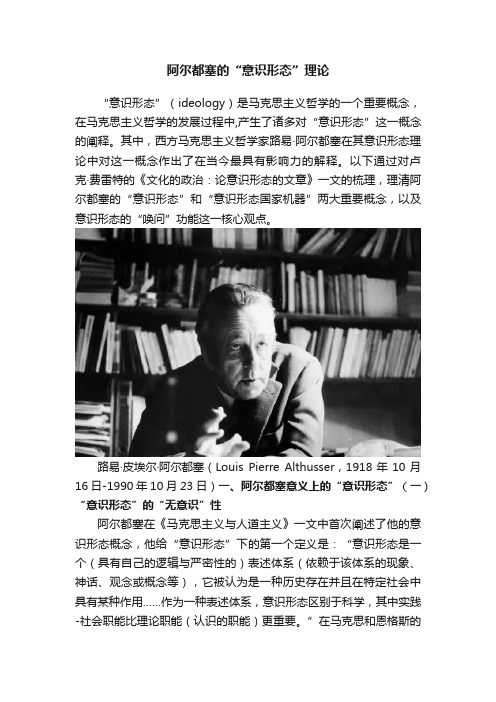
阿尔都塞的“意识形态”理论“意识形态”(ideology)是马克思主义哲学的一个重要概念,在马克思主义哲学的发展过程中,产生了诸多对“意识形态”这一概念的阐释。
其中,西方马克思主义哲学家路易·阿尔都塞在其意识形态理论中对这一概念作出了在当今最具有影响力的解释。
以下通过对卢克·费雷特的《文化的政治:论意识形态的文章》一文的梳理,理清阿尔都塞的“意识形态”和“意识形态国家机器”两大重要概念,以及意识形态的“唤问”功能这一核心观点。
路易·皮埃尔·阿尔都塞(Louis Pierre Althusser,1918年10月16日-1990年10月23日)一、阿尔都塞意义上的“意识形态”(一)“意识形态”的“无意识”性阿尔都塞在《马克思主义与人道主义》一文中首次阐述了他的意识形态概念,他给“意识形态”下的第一个定义是:“意识形态是一个(具有自己的逻辑与严密性的)表述体系(依赖于该体系的现象、神话、观念或概念等),它被认为是一种历史存在并且在特定社会中具有某种作用……作为一种表述体系,意识形态区别于科学,其中实践-社会职能比理论职能(认识的职能)更重要。
”在马克思和恩格斯的理论中,社会是由经济基础、上层建筑以及意识形态三个基本层面组成的结构的总和,而阿尔都塞在马克思和恩格斯的“社会”概念中增加了“科学”(首要是“历史唯物主义科学”)这一第四层面。
因此,阿尔都塞在上述定义中将意识形态描述成一种偏向于“实践-社会职能”而非“理论职能”的表述体系,是为了表明在资本主义社会中有两种根本不同的话语形式在起作用,即:为我们提供关于社会的真实认识的“科学”;以及,不为我们提供此种认识的“意识形态”。
故而在阿尔都塞看来,意识形态具有一种社会职能,但这种职能并不产生对社会历史真实状况的认识。
阿尔都塞认为,马克思和恩格斯在谈论意识形态时大量运用的“意识的形式”这一概念是一种前科学的语言。
他认为,不同于“意识的形式”这一概念的表层涵义,马克思和恩格斯所探讨的“意识形态”与“意识”之间几乎没有什么关系,相反,它是一个极端无意识的现象。
阿尔都塞意识形态国家机器理论及其当代启示

阿尔都塞意识形态国家机器理论及其当代启示【摘要】阿尔都塞的国家机器理论探讨了政治权力的运作机制,其中意识形态扮演关键角色。
意识形态的影响使国家机器成为意识形态的执行者,而国家机器在当代社会也经历了演变,对意识形态的影响程度进一步增加。
当代社会中,国家机器对意识形态的影响日益显现,同时国家机器理论也带来了一些当代启示,如政治权力的分散管理和意识形态的包容性。
阿尔都塞意识形态国家机器理论的重要性在于揭示政治实践中的权力运作机制,与当代社会的政治现实相辅相成。
对未来发展而言,我们需要思考如何在理论和实践中平衡政治权力和意识形态的关系,以促进社会的可持续发展和稳定。
【关键词】阿尔都塞、意识形态、国家机器理论、当代启示、政治现实、未来发展、影响、演变、重要性。
1. 引言1.1 阿尔都塞意识形态国家机器理论及其当代启示阿尔都塞意识形态国家机器理论是20世纪法国马克思主义学者路易·阿尔都塞提出的理论框架。
该理论认为国家机器不仅是政治权力的组织方式,更是对社会的强制性组织和管理。
意识形态则是国家机器运行的重要组成部分,通过意识形态的塑造和传播,国家机器能够巩固自身的统治地位。
当代社会中,国家机器已经不再是单纯的政治机构,而是一个庞大的体系,包括政府、媒体、教育机构等各种组织。
这些机构可以通过意识形态的渗透和宣传来影响人们的思想和行为。
随着信息技术的发展,国家机器也在不断演变和升级,其控制和监督能力日益增强。
在当代社会中,国家机器对意识形态的影响更加深远和广泛。
政府通过各种手段控制和引导民众的思想,塑造符合其统治需要的意识形态。
这种控制不仅仅局限于政治领域,还涉及经济、文化等各个方面。
阿尔都塞意识形态国家机器理论对当代社会具有重要的启示。
我们需要认识到国家机器的存在和影响,审视其对意识形态的塑造和操纵。
只有深入理解和抵制国家机器的控制,才能实现个体思想的自由和社会的进步。
2. 正文2.1 阿尔都塞的国家机器理论阿尔都塞的国家机器理论认为,国家是统治阶级为维护自身利益而建立的一种权力机构。
关于意识形态国家机器(AIE)的说明(译文)

关于意识形态国家机器(AIE)的说明路易•阿尔都塞说明:法国著名马克思主义哲学家路易〃阿尔都塞的著名论文《意识形态与意识形态国家机器:研究笔记》(法语简称AIE,英语简称ISAs)写于1969年初,他随后在1970年又写过一篇补充性的后记。
早在1980年代,这篇论文及其后记即由中国电影研究中心李迅和中央编译局杜章智二位先生各自译成中文,分别发表于《当代电影》杂志1987年第3、4期(后收入三联书店2006年版《外国电影理论文选》)和《马列主义研究资料》(人民出版社)1988年第4辑上。
此文近年又有多位译者重译并被收入多个中文译本当中,如齐泽克编《图绘意识形态》(方杰译,南京大学出版社2002年)以及陈越编《哲学与政治:阿尔都塞读本》(孟登迎译,吉林人民出版社2003年)。
实际上,阿尔都塞1970年以后还一直在关注意识形态国家机器的问题,他于1976年再次就“意识形态国家机器”又作了一些说明。
这些说明(笔记)是阿尔都塞进行自我批评之后的成果,体现了他对于意识形态国家机器及主体建构的看法已经发生了转变:即不再将主体看成只能被动认同支配性意识形态的位置(场所),而是可以召唤成具有反抗精神的战斗主体。
这一转变表现出与葛兰西理论相近的革命实践吁求,在阿尔都塞的思想发展上具有非常重要的转折意义。
近年来国内译介和研究阿尔都塞的理论已经渐成风气,但对这一转变似乎尚未给予应有的重视。
鉴于此,我们在此选译英国《经济与社会》杂志(Economy and Society,Volume12, Number4, November 1983, London:Routledge)1983年第4期上刊登过的这篇新笔记的摘要,以供大家参考。
一我在60-70年所写的那篇有关意识形态国家机器的文本,通常被认为是一篇“功能主义”的东西。
人们在我的理论草稿中看到了这样一种尝试,我所理解的马克思主义仅仅用各种功能来解释社会机构,这样一来直接使得社会等同于履行着镇压功能的意识形态机构,因而局限于一种非辩证的解释,其深层逻辑就是排除一切阶级斗争的可能性。
阿尔都塞:意识形态与形态国家机器(研究笔记)陈越修改稿
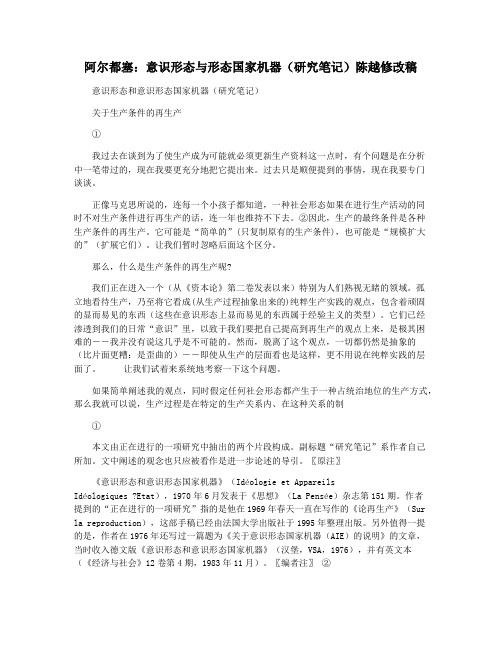
阿尔都塞:意识形态与形态国家机器(研究笔记)陈越修改稿意识形态和意识形态国家机器(研究笔记)关于生产条件的再生产①我过去在谈到为了使生产成为可能就必须更新生产资料这一点时,有个问题是在分析中一笔带过的,现在我要更充分地把它提出来。
过去只是顺便提到的事情,现在我要专门谈谈。
正像马克思所说的,连每一个小孩子都知道,一种社会形态如果在进行生产活动的同时不对生产条件进行再生产的话,连一年也维持不下去。
②因此,生产的最终条件是各种生产条件的再生产。
它可能是“简单的”(只复制原有的生产条件),也可能是“规模扩大的”(扩展它们)。
让我们暂时忽略后面这个区分。
那么,什么是生产条件的再生产呢?我们正在进入一个(从《资本论》第二卷发表以来)特别为人们熟视无睹的领域。
孤立地看待生产,乃至将它看成(从生产过程抽象出来的)纯粹生产实践的观点,包含着顽固的显而易见的东西(这些在意识形态上显而易见的东西属于经验主义的类型)。
它们已经渗透到我们的日常“意识”里,以致于我们要把自己提高到再生产的观点上来,是极其困难的――我并没有说这几乎是不可能的。
然而,脱离了这个观点,一切都仍然是抽象的(比片面更糟:是歪曲的)――即使从生产的层面看也是这样,更不用说在纯粹实践的层面了。
让我们试着来系统地考察一下这个问题。
如果简单阐述我的观点,同时假定任何社会形态都产生于一种占统治地位的生产方式,那么我就可以说,生产过程是在特定的生产关系内、在这种关系的制①本文由正在进行的一项研究中抽出的两个片段构成。
副标题“研究笔记”系作者自己所加。
文中阐述的观念也只应被看作是进一步论述的导引。
〖原注〗《意识形态和意识形态国家机器》(Idéologie et AppareilsIdéologiques ?Etat),1970年6月发表于《思想》(La Pensée)杂志第151期。
作者提到的“正在进行的一项研究”指的是他在1969年春天一直在写作的《论再生产》(Sur la reproduction),这部手稿已经由法国大学出版社于1995年整理出版。
电影的意识形态与意识形态国家机器

3.图形符号应该充满“想象力”。
阿恩海姆说过:“视觉形象永远不是对于感性材料的机械复制,而是对现实的一种创造性把握。
它把握的形象是含有丰富的想象性、创造性、敏锐性的美的形象。
观看世界的活动被证明是外部客观事物本身的性质与观看者的本性之间的相互作用。
”想象力是视觉艺术与观者的沟通桥梁,人们依赖一个个图形符号所形成的视觉空间,去感受快乐,去感悟和体验生活。
数字化为扩展电影的想象力和感染力提供了广阔的技术和艺术潜力。
《侏罗纪公园》、《星球大战》、《独立日》、《赛车总动员》、《狮子王》、《外星人》等为中国观众所熟悉的影片,除大量采用特技手段和电脑技术外,具有无尽想象力的视觉形象(动态图形符号)是这些影片共同的商业卖点和艺术亮点。
网络境域中的视觉艺术对今天的人们而言,有着不尽的诱惑力,其最为核心的原因就是各种或静或动的图形符号所营造出的充满想象力的虚拟世界。
4.图形符号应该体现与人的“互动”。
美国迪斯尼电影公司宣布了今后4年内将上映的10部动画片,其中8部动画新片均采取数码3-D技术制作,将在银幕上掀起“立体视觉”新浪潮。
“进一步采用3-D技术和电脑特效能帮助我们以最好的方式讲述故事,对此我们十分兴奋。
”迪斯尼和皮克斯动画影业的首席创意官约翰雷斯特表示。
“身临其境、游戏互动”,是多媒体视觉动画的艺术魅力,也是信息社会视觉艺术体现娱乐性和亲近感的主要意图。
受众通过视觉艺术中的图形符号进行互动解读,可以使自己身心愉悦,精神放松。
网络境域中的视觉艺术之所以能获得不同年龄段受众的喜爱,最突出的就是人们通过声、光、电、交互式参与等体会到了多感官的互动享受,体会到网络世界多人信息互动的快速反应和无限乐趣。
视觉设计艺术是研究人为事物的科学,是艺术与科学的交互与综合,其内核是社会文化的传递与超越,其本质是创造,同时,它作为视觉语言符号,又是信息传达的媒介和一种社会文化的载体。
面对人们对交互式、影像化和视觉交流方式等需求进行的深入探索和无止境渴求,数字技术背景下视觉艺术中的图形符号必须依赖艺术设计上的创新,同时要具备对社会文化进行视觉化思考和有一种文化审视和批判的精神。
阿尔都塞的“意识形态国家机器”释义

阿尔都塞的“意识形态国家机器”释义作者:罗国明来源:《法制与社会》2013年第06期摘要本文以阿尔都塞后期著作《意识形态和意识形态国家机器》为文本依据,对其意识形态国家机器理论进行了梳理与阐释,概括出意识形态国家机器的内涵、外延、特点、功能和运作方式。
关键词阿尔都塞意识形态国家机器国家理论意识形态作者简介:罗国明,中山大学南方学院思想政治教学部教师,研究方向:政治哲学。
中图分类号:D90文献标识码:A文章编号:1009-0592(2013)02-140-02“意识形态国家机器”是法国左派思想家路易·阿尔都塞(Louis Althusser,1918-1990)率先提出的一个概念。
他1970年在法国共产党机关刊物《思想》杂志发表了《意识形态和意识形态国家机器》一文,集中阐述了其意识形态国家机器理论。
在阿尔都塞看来,传统马克思主义国家理论中的“国家”是指主要以暴力的、镇压的方式执行职能的军队、警察、法庭、行政机构等镇压机器。
而他所提出的“意识形态国家机器”则是指教会、学校、家庭等主要以非暴力的、意识形态的方式执行国家职能的专门机构。
“意识形态国家机器”正是相对于“镇压性国家机器”而言的。
阿尔都塞认为,为了更好地理解国家在执行职能时的活动方式,更好地理解资本主义生产条件的再生产,必须把意识形态国家机器理论补充到马克思主义国家理论中去,把对“国家”的理解从镇压机器扩展到意识形态机器。
一、意识形态国家机器的内涵、外延和特点在《意识形态和意识形态国家机器》一文中,阿尔都塞并没有给意识形态国家机器下一个明确的定义,他只是说:“我会把意识形态国家机器称作是一些以独特和专门机构的形式呈现在直接观察者面前的现实。
”①这个“定义”显然还是一个过于宽泛的指谓,不足以概括意识形态国家机器的内涵。
不过,阿尔都塞倒是“以经验为根据”列举了诸种“以实践状态存在”的意识形态国家机器(这构成了意识形态国家机器的外延)。
他指出:“我们暂时还是可以把下述机构看成是意识形态的国家机器(我列举的次序没有任何特别意义):——宗教的意识形态国家机器(各种教会体系);——教育的意识形态国家机器(各种公私立‘学校’的体系);——家庭的意识形态国家机器;——法律的意识形态国家机器;——政治的意识形态国家机器(包括不同政党在内的政治体系);——工会的意识形态国家机器;——传播的意识形态国家机器(出版物、广播和电视等);——文化的意识形态国家机器(文学、艺术、体育等)”。
关于意识形态国家机器(AIE)的说明(译文)
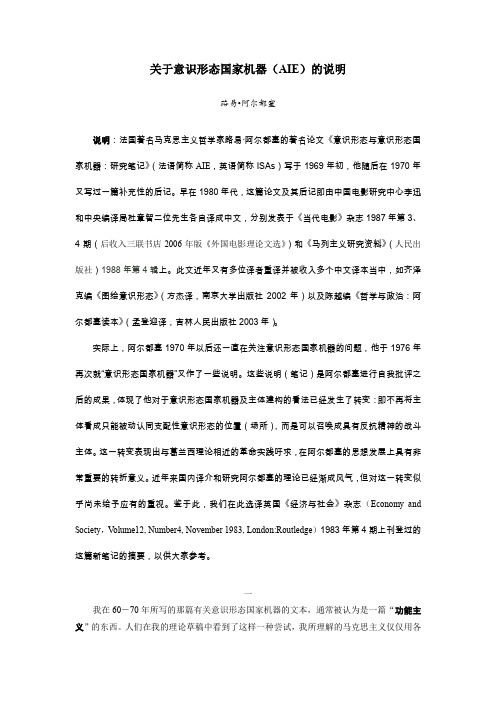
关于意识形态国家机器(AIE)的说明路易•阿尔都塞说明:法国著名马克思主义哲学家路易·阿尔都塞的著名论文《意识形态与意识形态国家机器:研究笔记》(法语简称AIE,英语简称ISAs)写于1969年初,他随后在1970年又写过一篇补充性的后记。
早在1980年代,这篇论文及其后记即由中国电影研究中心李迅和中央编译局杜章智二位先生各自译成中文,分别发表于《当代电影》杂志1987年第3、4期(后收入三联书店2006年版《外国电影理论文选》)和《马列主义研究资料》(人民出版社)1988年第4辑上。
此文近年又有多位译者重译并被收入多个中文译本当中,如齐泽克编《图绘意识形态》(方杰译,南京大学出版社2002年)以及陈越编《哲学与政治:阿尔都塞读本》(孟登迎译,吉林人民出版社2003年)。
实际上,阿尔都塞1970年以后还一直在关注意识形态国家机器的问题,他于1976年再次就“意识形态国家机器”又作了一些说明。
这些说明(笔记)是阿尔都塞进行自我批评之后的成果,体现了他对于意识形态国家机器及主体建构的看法已经发生了转变:即不再将主体看成只能被动认同支配性意识形态的位置(场所),而是可以召唤成具有反抗精神的战斗主体。
这一转变表现出与葛兰西理论相近的革命实践吁求,在阿尔都塞的思想发展上具有非常重要的转折意义。
近年来国内译介和研究阿尔都塞的理论已经渐成风气,但对这一转变似乎尚未给予应有的重视。
鉴于此,我们在此选译英国《经济与社会》杂志(Economy and Society,Volume12, Number4, November 1983, London:Routledge)1983年第4期上刊登过的这篇新笔记的摘要,以供大家参考。
一我在60-70年所写的那篇有关意识形态国家机器的文本,通常被认为是一篇“功能主义”的东西。
人们在我的理论草稿中看到了这样一种尝试,我所理解的马克思主义仅仅用各种功能来解释社会机构,这样一来直接使得社会等同于履行着镇压功能的意识形态机构,因而局限于一种非辩证的解释,其深层逻辑就是排除一切阶级斗争的可能性。
阿尔都塞‖意识形态与意识形态的国家机器
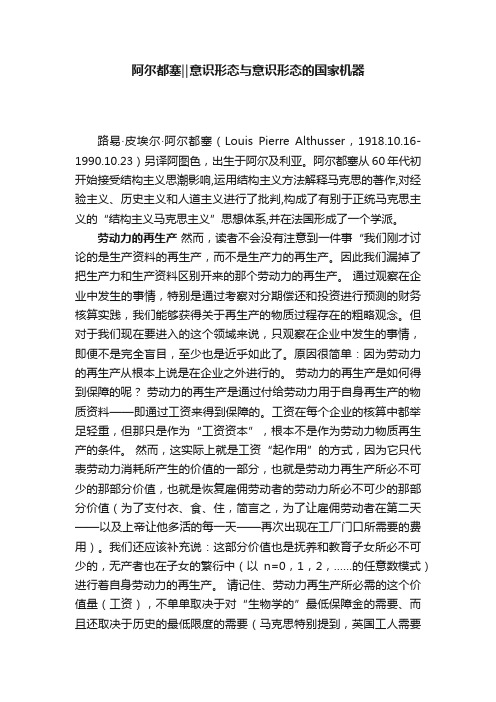
阿尔都塞‖意识形态与意识形态的国家机器路易·皮埃尔·阿尔都塞(Louis Pierre Althusser,1918.10.16-1990.10.23)另译阿图色,出生于阿尔及利亚。
阿尔都塞从60年代初开始接受结构主义思潮影响,运用结构主义方法解释马克思的著作,对经验主义、历史主义和人道主义进行了批判,构成了有别于正统马克思主义的“结构主义马克思主义”思想体系,并在法国形成了一个学派。
劳动力的再生产然而,读者不会没有注意到一件事“我们刚才讨论的是生产资料的再生产,而不是生产力的再生产。
因此我们漏掉了把生产力和生产资料区别开来的那个劳动力的再生产。
通过观察在企业中发生的事情,特别是通过考察对分期偿还和投资进行预测的财务核算实践,我们能够获得关于再生产的物质过程存在的粗略观念。
但对于我们现在要进入的这个领域来说,只观察在企业中发生的事情,即便不是完全盲目,至少也是近乎如此了。
原因很简单:因为劳动力的再生产从根本上说是在企业之外进行的。
劳动力的再生产是如何得到保障的呢?劳动力的再生产是通过付给劳动力用于自身再生产的物质资料——即通过工资来得到保障的。
工资在每个企业的核算中都举足轻重,但那只是作为“工资资本”,根本不是作为劳动力物质再生产的条件。
然而,这实际上就是工资“起作用”的方式,因为它只代表劳动力消耗所产生的价值的一部分,也就是劳动力再生产所必不可少的那部分价值,也就是恢复雇佣劳动者的劳动力所必不可少的那部分价值(为了支付衣、食、住,简言之,为了让雇佣劳动者在第二天——以及上帝让他多活的每一天——再次出现在工厂门口所需要的费用)。
我们还应该补充说:这部分价值也是抚养和教育子女所必不可少的,无产者也在子女的繁衍中(以n=0,1,2,……的任意数模式)进行着自身劳动力的再生产。
请记住、劳动力再生产所必需的这个价值量(工资),不单单取决于对“生物学的”最低保障金的需要、而且还取决于历史的最低限度的需要(马克思特别提到,英国工人需要啤酒,而法国无产者需要葡萄酒),即一种随历史变动的最低限度的需要。
阿尔都塞意识形态国家机器理论及其当代启示
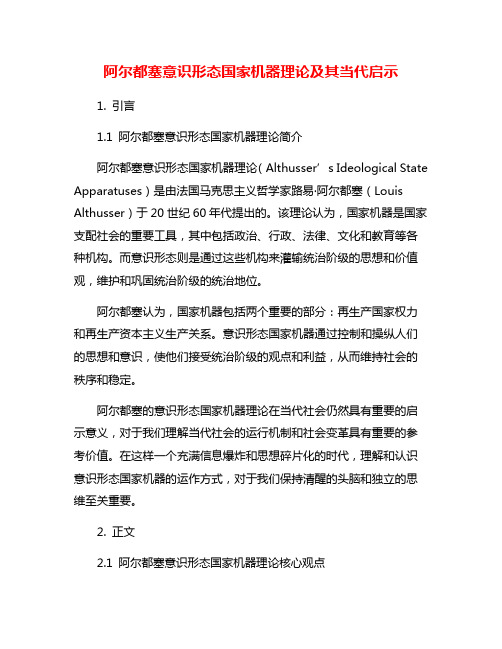
阿尔都塞意识形态国家机器理论及其当代启示1. 引言1.1 阿尔都塞意识形态国家机器理论简介阿尔都塞意识形态国家机器理论(Althusser’s Ideological State Apparatuses)是由法国马克思主义哲学家路易·阿尔都塞(Louis Althusser)于20世纪60年代提出的。
该理论认为,国家机器是国家支配社会的重要工具,其中包括政治、行政、法律、文化和教育等各种机构。
而意识形态则是通过这些机构来灌输统治阶级的思想和价值观,维护和巩固统治阶级的统治地位。
阿尔都塞认为,国家机器包括两个重要的部分:再生产国家权力和再生产资本主义生产关系。
意识形态国家机器通过控制和操纵人们的思想和意识,使他们接受统治阶级的观点和利益,从而维持社会的秩序和稳定。
阿尔都塞的意识形态国家机器理论在当代社会仍然具有重要的启示意义,对于我们理解当代社会的运行机制和社会变革具有重要的参考价值。
在这样一个充满信息爆炸和思想碎片化的时代,理解和认识意识形态国家机器的运作方式,对于我们保持清醒的头脑和独立的思维至关重要。
2. 正文2.1 阿尔都塞意识形态国家机器理论核心观点阿尔都塞认为国家是一个意识形态机器,其目的是为了维护和巩固统治阶级的利益。
国家通过意识形态的宣传和控制手段来操纵和控制人民的思想和行为,以确保统治阶级的统治地位不受动摇。
阿尔都塞强调国家机器的意识形态作用是通过意识形态设备和国家机器的结合来实现的。
意识形态设备包括学校、媒体、宗教等,它们通过灌输意识形态来影响人们的观念和价值观;而国家机器则通过政治、法律等手段来强化意识形态的传播和执行。
阿尔都塞指出国家机器的运作是通过对权力和暴力的控制来实现的,国家通过威权主义、宣传机器和暴力机器等手段来维护统治秩序,强化意识形态的传播和执行。
2.2 当代社会的意识形态国家机器当代社会的意识形态国家机器在阿尔都塞的理论中被定义为现代国家通过宣传、教育、媒体等手段来操纵和控制人们的意识形态的体系。
阿尔都塞的意识形态国家机器理论
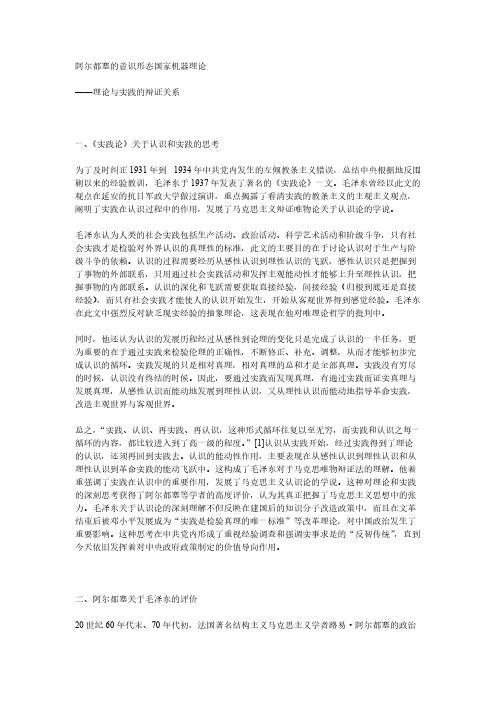
阿尔都塞的意识形态国家机器理论——理论与实践的辩证关系一、《实践论》关于认识和实践的思考为了及时纠正1931年到1934年中共党内发生的左倾教条主义错误,总结中央根据地反围剿以来的经验教训,毛泽东于1937年发表了著名的《实践论》一文。
毛泽东曾经以此文的观点在延安的抗日军政大学做过演讲,重点揭露了看清实践的教条主义的主观主义观点,阐明了实践在认识过程中的作用,发展了马克思主义辩证唯物论关于认识论的学说。
毛泽东认为人类的社会实践包括生产活动、政治活动、科学艺术活动和阶级斗争,只有社会实践才是检验对外界认识的真理性的标准,此文的主要目的在于讨论认识对于生产与阶级斗争的依赖。
认识的过程需要经历从感性认识到理性认识的飞跃,感性认识只是把握到了事物的外部联系,只用通过社会实践活动和发挥主观能动性才能够上升至理性认识,把握事物的内部联系。
认识的深化和飞跃需要获取直接经验,间接经验(归根到底还是直接经验),而只有社会实践才能使人的认识开始发生,开始从客观世界得到感觉经验。
毛泽东在此文中强烈反对缺乏现实经验的抽象理论,这表现在他对唯理论哲学的批判中。
同时,他还认为认识的发展历程经过从感性到论理的变化只是完成了认识的一半任务,更为重要的在于通过实践来检验伦理的正确性,不断修正、补充、调整,从而才能够初步完成认识的循环。
实践发现的只是相对真理,相对真理的总和才是全部真理。
实践没有穷尽的时候,认识没有终结的时候。
因此,要通过实践而发现真理,有通过实践而证实真理与发展真理,从感性认识而能动地发展到理性认识,又从理性认识而能动地指导革命实践,改造主观世界与客观世界。
总之,“实践、认识、再实践、再认识,这种形式循环往复以至无穷,而实践和认识之每一循环的内容,都比较进入到了高一级的程度。
”[1]认识从实践开始,经过实践得到了理论的认识,还须再回到实践去。
认识的能动性作用,主要表现在从感性认识到理性认识和从理性认识到革命实践的能动飞跃中。
阿尔都塞的“意识形态”:从理论到实践的转型

阿尔都塞的“意识形态”:从理论到实践的转型摘要:在阿尔都塞中期的思想体系中,意识形态作为科学的对立面出现。
而在经历了20世纪60年代末的社会动荡之后,阿尔都塞渐渐转向在现实政治领域探讨对意识形态的超越,着重于对阶级社会中意识形态自身结构的学理化解析。
在意识形态断裂的前后不同阶段,作者对意识形态遮蔽性的批判和在此基础上对意识形态的超越始终处于辩证矛盾的关系中,具有作者所处时代的鲜明特征。
关键词:意识形态;认识论断裂;理论化;政治化;理论转型在20世纪的西方马克思主义理论家中,阿尔都塞是一位具有代表性的人物。
作为巴黎高师几代知识分子的精神领袖,他的理论是“对马克思主义所做的最为警觉和最为现代的再阐释”(德里达),而他一生的荣辱起伏在那个思想激荡的历史时期里留下了深深的印痕。
与其他的西方马克思主义者一样,阿尔都塞理所当然地作为“对象”出现在文本的解读中。
在阿尔都塞的理论体系中,马克思的理论经历了从意识形态向科学的认识论的转型,他将这一转型称为“认识论的断裂”。
这一点在他20世纪60年代中期的著作《保卫马克思》中已经作了明确的阐述,并一直延续到晚期的思想建构中。
而在作者自身的理论体系里,我们可以发现同构式的“认识论断裂”,就像在阐述马克思历史唯物主义理论时提出的那样,阿尔都塞在理论上的转型同样是隐蔽的。
“意识形态”在后期的理论中以“旧概念”的形式出现,成为“既看不见又看得见,既没有出现又现实存在的关键性概念”。
这一转型不仅仅是个别概念的内涵变动,而且是理论结构层次上的重新定位,是总问题的转换。
对于理论结构来说,“意识形态”作为一个概念会在某些特定的表述形式以及与之相对应的论述中显现为某些理论结果,而这一显现往往是“沉默”的过程。
在下面的叙述中我们将对这一“沉默”的转型做出具体的说明和解释。
一阿尔都塞断裂前的意识形态理论是通过对《资本论》的哲学解读来实现的。
对著作的“哲学解读”是提出著作及其对象的关系问题,同时也就提出了著者所论述的对象的特殊性问题。
阿尔都塞《意识形态国家机器》阅读笔记
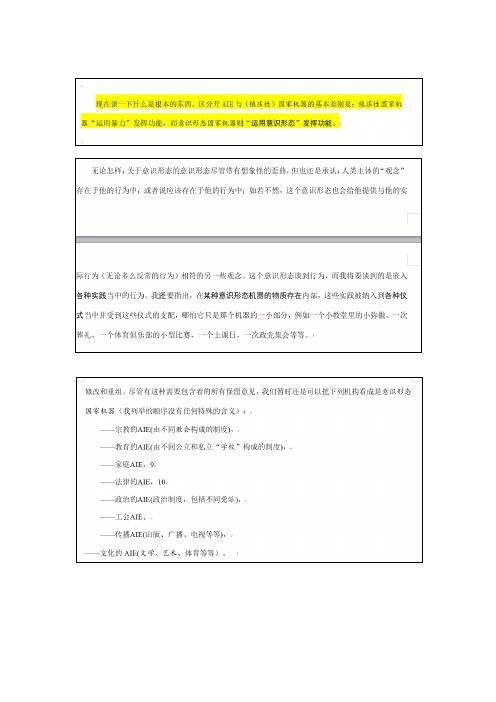
这样的其它机构,像这样的其它机器)给人传授“本领”,无非是以保障人们或者保障他们掌握这种“实践”的形式进行的。
所有那些从事生产、剥削和镇压的当事人,更不用说那些“意识形态专家”(马克思语),为了要“凭良心”克尽职守——被剥削者(无产者)、剥削者(资本家)、剥削者的助手(管理者)或者占统治地位的意识形态的权威(它的“官员”)等等各自的职守——都必定以这样那样的方式“浸染”在占统治地位的意识形态当中。
机器把定义为在资产阶级及其同盟者所展开的反对无产阶级的斗争中,“为维护统治阶级的利益”而实施的镇压和干预的力量;这样的机器才是真正的,才真正定义了它的基本“功能”。
统治阶级事实上在中同样握有主动权,因为最终总是占统治地位的意识形态在里(恰恰是在它内部的矛盾中)获得了实现。
一个个人会信仰上帝、、等等。
(对于每个人来说,即对所有那些生活在对意识形态的意识形态表述——这种表述把意识形态归结为各种观念,并把它们定义为精神的存在——当中的人来说)这种信仰源于这个个人的观念,即源于这个作为有意识的主体的个人:他的意识里包含了他信仰的观念。
以这种方式,即借助于这样建立起来的纯粹意识形态“概念的”配置(一个被赋予了意识、并在这种意识中自由地形成或自由地认识他所信仰的观念的主体),这个主体的(物质的)姿态也就自然地出现了。
无论怎样,关于意识形态的意识形态尽管带有想象性的歪曲,但也还是承认:人类主体的“观念”存在于他的行为中,或者说应该存在于他的行为中;如若不然,这个意识形态也会给他提供与他的实际行为(无论多么反常的行为)相符的另一些观念。
这个意识形态谈到行为,而我将要谈到的是嵌入当中的行为。
我要指出,在内部,这些实践被纳入到当中并受到这些仪式的支配,哪怕它只是那个机器的一小部分,例如一个小教堂里的小弥撒、一次葬礼、一个体育俱乐部的小型比赛、一个上课日、一次政党集会等等。
观念(就它们具有一种观念的或精神的存在而言)就这样消失了,但确切地说,是出现了这样的情况:它们的存在被纳入了实践的行为,这些实践受到仪式的支配,而这些仪式归根到底又是由意识形态机器来规定的。
- 1、下载文档前请自行甄别文档内容的完整性,平台不提供额外的编辑、内容补充、找答案等附加服务。
- 2、"仅部分预览"的文档,不可在线预览部分如存在完整性等问题,可反馈申请退款(可完整预览的文档不适用该条件!)。
- 3、如文档侵犯您的权益,请联系客服反馈,我们会尽快为您处理(人工客服工作时间:9:00-18:30)。
67
读《意识形态和意识形态国家机器》
宋立宁
( 北京师范大学文学院,北京 100075 )
【摘 要】《意识形态和意识形态国家机器》进一步发展了马克思主义的意识形态理论,并提出了“意识形态国家机器”的理念,认为个体意识必须融入社会意识,意识形态是一个时代或社会的自我意识。
本文作者认为意识形态不能等同于统治阶级的意识形态,而社会的意识不仅仅包括统治阶级的意识,还包括其它阶层和个体的意识【关键词】意识形态;个体意识;社会意识;社会形态
阿尔都塞在《意识形态和意识形态国家机器》中进一步发展了马克思主义的意识形态理论,并提出了“意识形态国家机器”的理念,这篇文章的阅读是一个非常艰难的工程,在我费尽心力的理解了其中部分艰涩概念的同时,也对其中的部分观点有不同的看法,在这里姑且表达自己对于这篇文章的粗浅思考吧。
阿尔都塞认为意识形态在维系社会生活、阶级统治和社会形态上都发挥着非常重要的作用,用简单易懂的话来说,意识形态融合在我们出生以来接收的一切信息之中,对我们造成潜移默化并持续不断的影响,将我们塑造成符合意识形态的样子,统治者因此具有统治阶级的思想,被统治者也因此能够理所当然并以为自己是心甘情愿的接受统治。
在这个方面来说,意识形态成为一种国家机器,如果说军队、警察等国家机器是通过硬性的方式维护国家稳定,那么意识形态就是通过软性的方式让人们接受国家的统治,通过学校、宗教、媒体等等渠道,进行一种类似于“催眠”、“洗脑”的教育与宣传,在维护统治的方面作用甚至比军队更加重要。
阿尔都塞的意识形态类似于一种催眠的幻觉,让人作为一个个体,而在意识形态中认为自己是主体,从而愉快自觉的履行自己的任务,他将意识形态与“无意识”并列,人们并不能意识到它的存在,而不知不觉间已经被他所同化,正是这一点让我有些不敢苟同,因为如果这样来看,人作为一个个体的主观能动性无意被削弱了,而且这样的话人岂不是带有一种无法避免的悲剧感吗?
这种悲剧感正是我难以接受的,因为在阿尔都塞的理论之中,人在意识形态面前似乎是毫无还手之力——意识形态是无意识的,如果连意识到它都无法做到,当然更无法决定面对他的态度和应对。
似乎人一出生——或者更进一步的说,在出生之前,就已经被注定了日后要接受的意识形态,而无法做出自主的选择,沉浸在虚妄的幻觉之中。
这固然会维持社会的稳定和统治的稳固,但作为人这个个体而言,却一直被蒙蔽在虚假的幸福之中,无法看清真相,或许真相其实并不重要也没有意义,但作为人来说想要把握自己的生活是最基本的追求,千百年来人类正是为了这个而不断的努力、不断的发展,如果这一切始终仍笼罩在意识形态的幻境之中,人从来不曾清醒,岂不是太过悲哀了吗?
意识形态是如何将人从个体变为主体呢?我姑且用比较通俗简单的方法转述阿尔都塞的描写,意识形态向人发出质询——这时人尚且是作为一个个体而存在的,在人回应了意识形态的质询,合乎意识形态的规范时,他便被意识形态所接收,成为其中的一部分,也从个体转变成了主体。
但是必须承认的是并不是每一个人都会回应意识形态的质询,必然有人拒
绝回应,保留自己的个体性,不融入意识形态之中,这样的人确实存在,但作为不被意识形态所承认个体,他们往往无法融入社会,会被社会上所排斥,进而很难在这个社会上生存下去。
这是因为阿尔都塞将意识形态与社会意识大体上合并了,并且他提出意识形态是没有历史的,亦即认为意识形态无论在什么社会形态下都是存在的,但这里有一个矛盾,从远古到现在社会形态不断发生改变,从奴隶制到封建社会,又到资本主义社会,再到社会主义社会,如果按照阿尔都塞的理论,意识形态塑造统治阶级和被统治阶级的意识,使他们无意识中接受自己的地位,那么社会形态应该十分稳固。
但是另一方面,意识形态始终与阶级相联系,而在社会中绝不会只存在一个阶级,因此意识形态也是阶级斗争的场所,甚至与现实中的战场交锋、统治阶级改变相比,新生阶级的意识形态在它还未成为统治阶级时已经存在,而被推翻的旧阶级的意识形态也不会马上消失,他们会在意识形态的领域继续斗争,因此意识形态领域的阶级斗争可以说比现实中物质上的斗争更加持久也更加激烈,是无时无刻不在进行的。
从上述分析来看,关于意识形态与人的个体性之间的矛盾,或者可以发现阿尔都塞有所欠缺的地方。
意识形态是一个时代或社会的自我意识,但阿尔都塞将意识形态很大程度上等同于统治阶级的意识形态,而社会的意识不仅仅包括统治阶级的意识,还包括其它阶层和个体的意识。
个体总可以划分入不同的阶层或阶级之中,也就是说统一阶级内部的个体意识和该阶级的意识确实有很大的共同性,但首先我们不能就此将两者等同,其次社会上区别于统治阶级的其它阶级仍然存在,因此统治阶级的意识形态——也即阿尔都塞在文章中所描述的意识形态,进行质询的时候不可能得到全部社会成员的回应。
《意识形态和意识形态国家机器》这篇文章无疑是在哲学范畴之中的,其中揭示的道理深刻反映了社会生活的实际样貌,但正如我在上面提到的,阿尔都塞的意识形态理论带来了个人主体性的悲剧,哲学是窥见真实的学问,但真实未必就是美好,作为一个普通人,或者活在蒙蔽之中未尝不是一种幸福。
这点感慨并不深刻,也不太符合这篇文章探讨的内容,但这确实是我读过阿尔都塞先生的《意识形态和意识形态国家机器》后的真是感想。
参考文献:
[1]路易·阿尔都塞.意识形态和意识形态国家机器[J].La Pensée,1970,6,151.[2]邓细芳.阿尔都塞意识形态理论评析[D].华中师范大学,2008.
作者简介:宋立宁,女,就读于北京师范大学文学院汉语言文学专业,擅长中国古典文学研究,中西比较文化研究。
